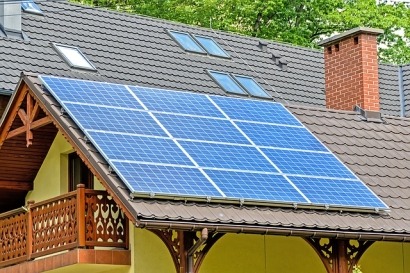
Historic housing protection laws often stand in the way of upgrading old buildings. Therefore, it’s not always possible to install green energy sources — like solar panels or wind turbines — in old homes. However, if regulations allow, there are several ways to incorporate renewable power without sacrificing a home’s integrity or historic character.
Solar panels are a popular choice for renewable energy, but historic homeowners may face opposition when trying to incorporate these sources. For example, Washington, D.C. plans to generate 10% of its renewable energy with solar panels by 2032, but the plan faces pushback from historic preservation officials.
Although the law may preclude their use on historic buildings, some looser regulations allow homeowners to install photovoltaic panels as long as they don’t obscure historic rooflines. For example, placing solar panels on the side of a pitched roof — as long as it doesn’t face the street — is allowed in many cases. In some cases, it may be permissible to install pole-mounted solar arrays on hidden areas of the property.
Wind turbines are noisy, but they can be a great choice for old homes in rural areas. Regulations may prevent homeowners from installing wind turbines that obscure or alter the appearance of a historic building. However, if there is a way to incorporate them in an out-of-the-way location, owners may be allowed to use wind turbines to power their historic homes.
The International Energy Agency (IEA) aims to help the world meet the net zero emissions goals by 2050, one of which is for geothermal energy power to increase by 13% in per-year gains from 2021 to 2030.
Although geothermal energy systems require major excavations, it’s possible to incorporate them without changing a home’s outward appearance. The three most common types of underground geothermal systems are horizontal, vertical and pond loops.
Many old houses have gas stoves or heaters. In addition to being bad for the environment, indoor gas systems are detrimental to human health. Upgrading to electric stoves and heaters is an easy way to make older homes more renewable and livable.
In addition to adding renewable energy sources, there are several ways homeowners can improve an old home’s efficiency. These techniques pair synergistically with renewable energy use.
A settling basement can lead to increased utility bills in two ways. First, if water raises the basement’s humidity levels, hot air may rise through the floor and spread throughout the rest of the home. That means the air conditioner will have to work harder to decrease the temperature.
Secondly, basement settlements can open up cracks that let in cold or hot air from the outdoors. Fixing problems with the basement can go a long way toward improving energy efficiency.
Old homes often come equipped with old HVAC systems. Replacing the entire system would ideally offer the most energy efficiency, but that isn’t always possible due to regulations or sheer difficulty.
Instead, homeowners may be able to install smart thermostats. A smart thermostat carefully regulates the temperature throughout the home depending on the day, time, outdoor temperature and even building occupancy levels. It also doesn’t alter the appearance or structure of the building.
Some historic homes have single-pane windows that offer little in the way of insulation. Newer windows may have multiple panes and thicker glass to conserve as much energy as possible. The best part is that they come in multiple styles, so there’s no need to change an old home’s appearance for the sake of energy efficiency.
Sealing around windows and doors goes a long way. Additionally, installing thicker insulation in the attic, walls and basement can dramatically improve a home’s energy efficiency. It’s also worth noting that homes built between 1930 and 1950 may contain asbestos-based insulation. Replacing it will improve the safety and livability of the home.
Although historic buildings may not come with green energy sources, homeowners can install solar panels, wind turbines or electric stoves if regulations allow. Additionally, there are several ways to boost a home’s overall energy efficiency, including replacing outdated appliances, installing new windows and repairing cracks. It’s possible to bring a home into the 21st century without sacrificing its original charm.

